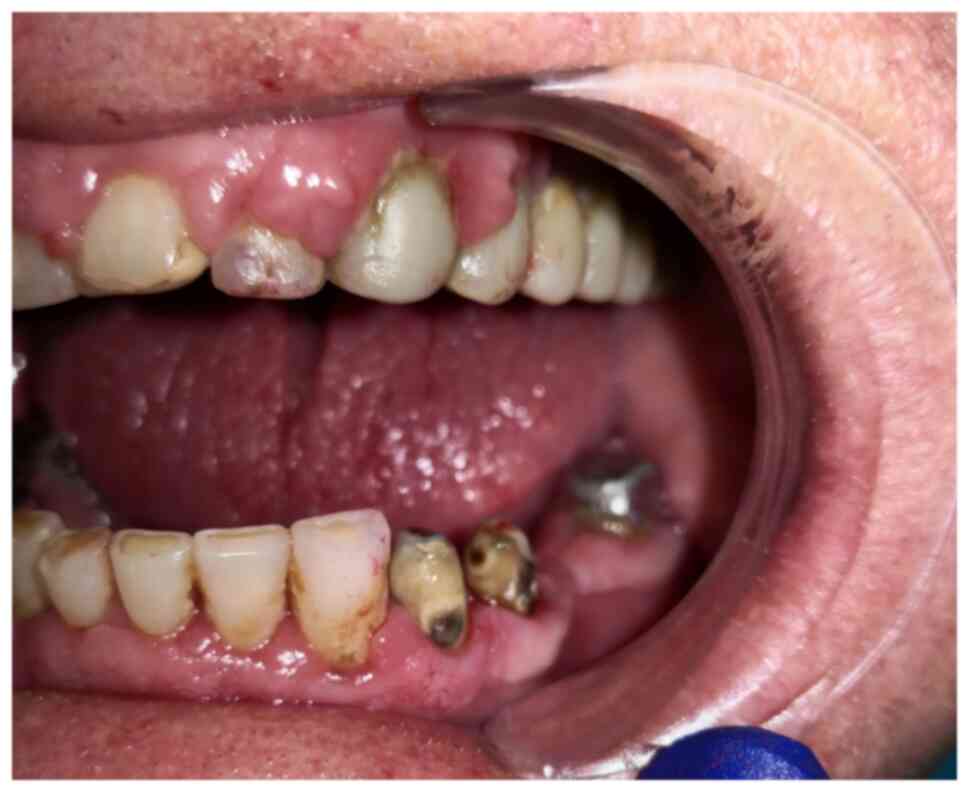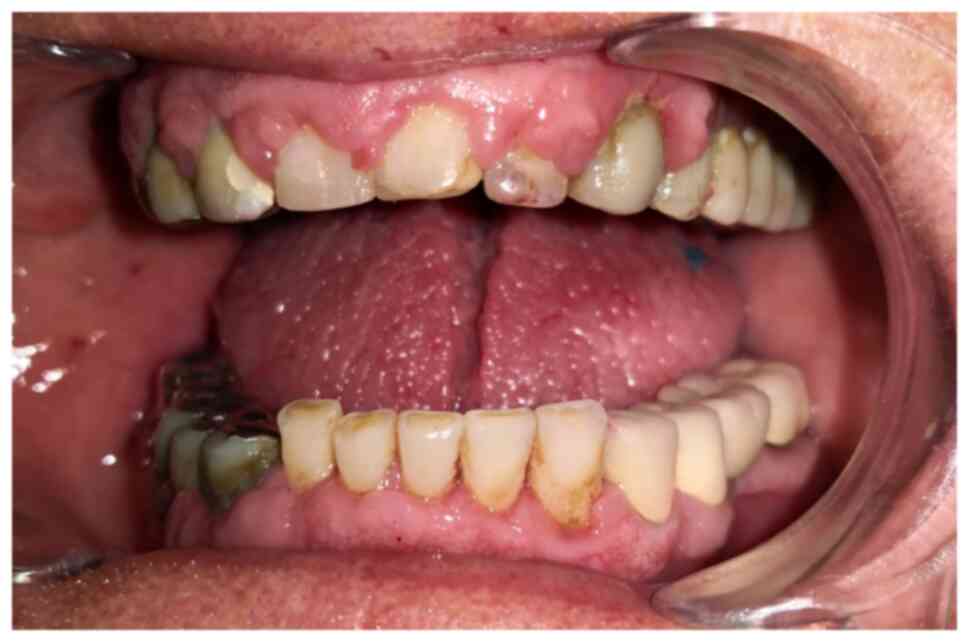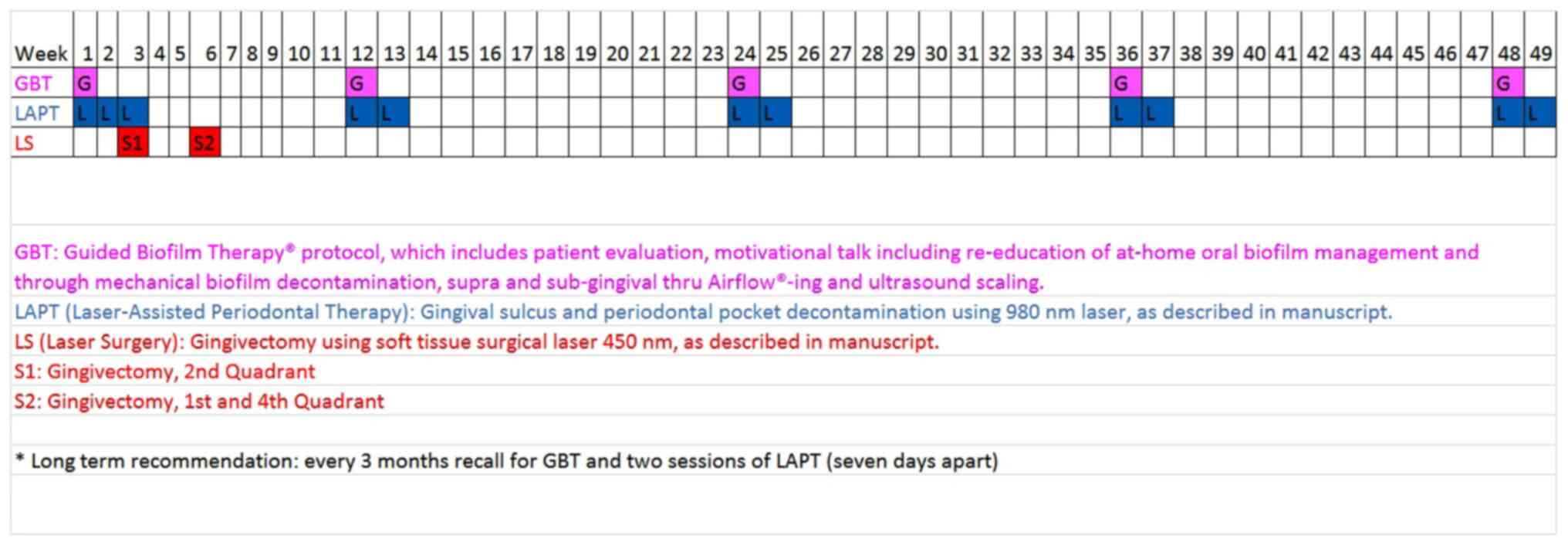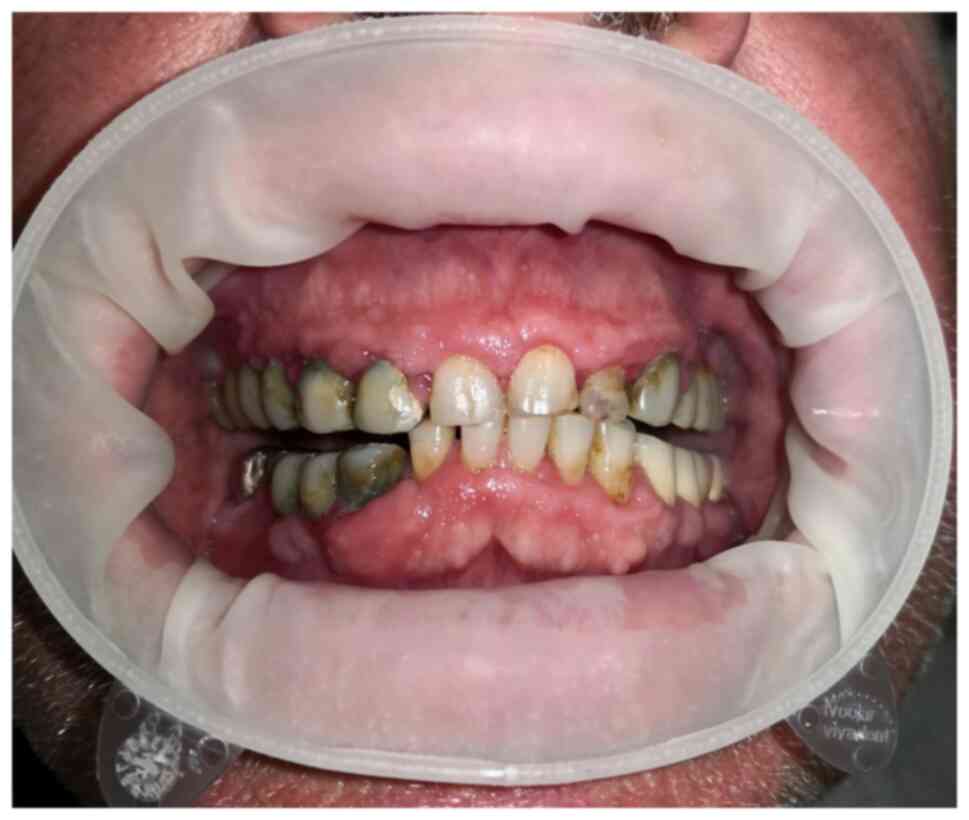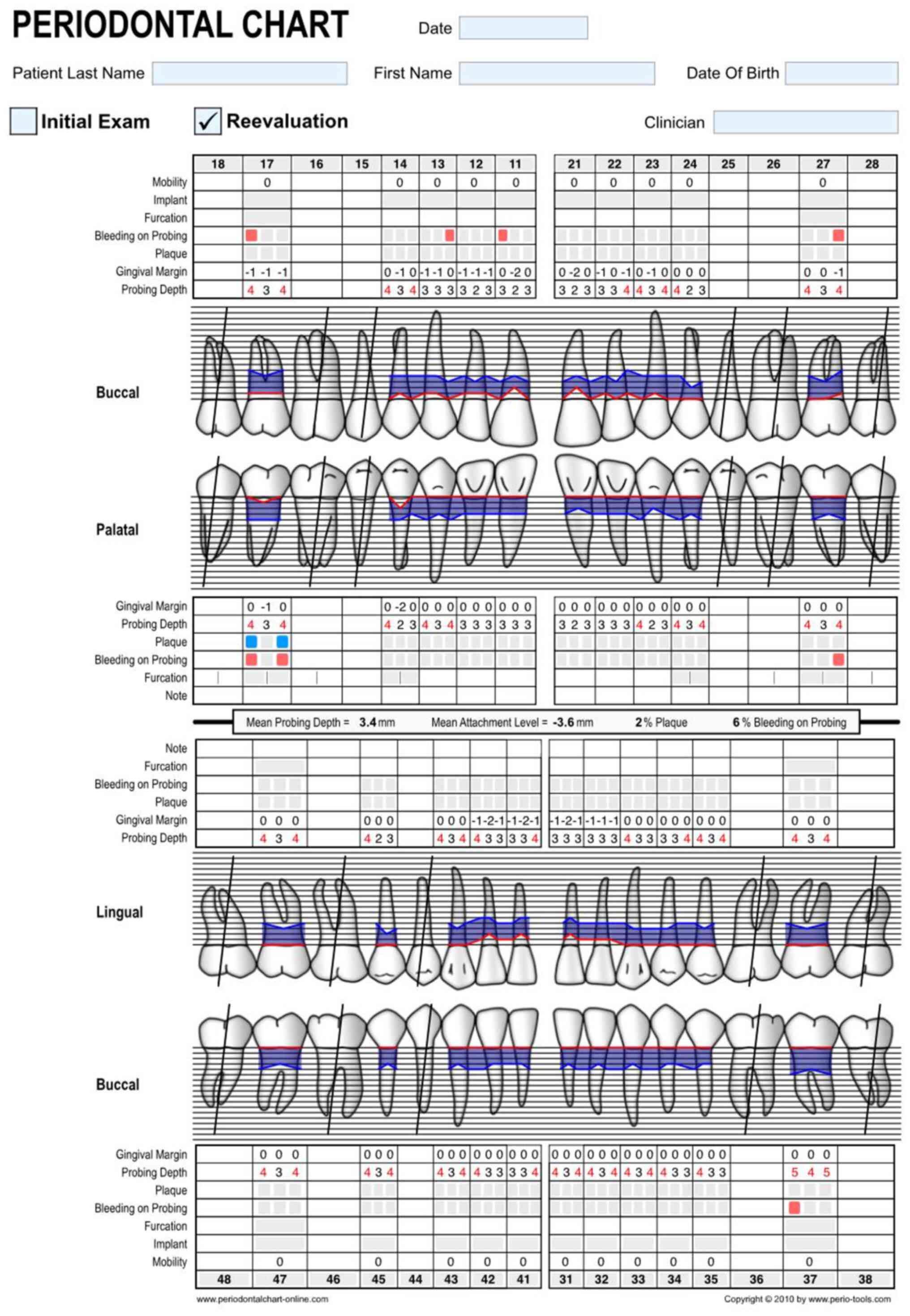Gingival overgrowth approached using recent mechanical and laser technologies: A case report
- Authors:
- Published online on: January 8, 2024 https://doi.org/10.3892/etm.2024.12374
- Article Number: 84
-
Copyright: © Mihai et al. This is an open access article distributed under the terms of Creative Commons Attribution License.
Abstract
Introduction
It is well known and proven by a number of studies over the last 60 years, that the primary etiologic factor in periodontal disease is the oral bacterial plaque (1-4). Other factors such as smoking, diabetes, vicious habits (bruxism and occlusal trauma), dentoalveolar incongruity, including some drugs such as antiepileptic and some antihypertensive (as calcium channel blockers) medication are considered as additional risk factors, some with higher pathological influence than others.
The physio-pathological mechanism of calcium channel blockers-influenced gingival overgrowth involves an association between the decrease in the catabolic events (derived from decreasing of cation influx and folic acid transport within the fibroblasts in the gingiva) and the increase in the anabolic events in the gingiva (triggered by increased synthesis of keratinocyte growth factor by fibroblasts and decreased aldosterone), which end up in the accumulation of collagen and ground substance (4,5). However, no matter which one of these proposed mechanisms is considered, all studies show direct involvement of the dental plaque, as a sine qua non factor, in the process (4,5). The inflammatory and non-inflammatory mechanisms underlying this type of drug-influenced gingival growth impede different stages of the disease.
In these patients, there is also a vicious circle effect: The gingival overgrowth promotes dental plaque retention on increased gingival surfaces, and concurrently, the development of false periodontal pockets provide favorable conditions for the formation of the higher pathogenic anaerobic flora (6). Of course, the poorly marginally adapted prosthodontics play also an important role in excessive plaque retention and act as irritating spikes for the already inflamed gingiva.
In the great majority of these patients, other favoring factors coexist, thus creating the full picture of a true periodontal disease: Smoking, diabetes, and, most important and most often, the poor home management of dental hygiene.
Consequently, the treatment of these patients should begin with the thorough removal of the bacterial plaque and the favorable factors that can be removed (re-education of the patient about oral hygiene and removal of fixed prosthetic works or marginally unsuited restorations).
At present, there are new generation methods, more efficient and less invasive, available both for bacterial decontamination and surgical excision part: For decontamination there is mechanical decontamination according to the guided biofilm therapy (GBT) protocol (7,8) (including patient re-education/motivation) and laser decontamination; laser-assisted nonsurgical periodontal pocket therapy at 980 nm (9-14). For the surgical excision of the overgrown gingiva, the use of a 450-nm laser is the most efficient and least invasive method (minimum tissue necrosis in depth) (15-17), with the fastest and most comfortable healing for the patient and with the lowest recurrence rate (18-25).
Case report
Patient
Regarding the clinical case presented below, a patient was chosen with gingival hyperplasia influenced by calcium channel blockers, with no other risk factors except higher plaque retention caused by fixed prosthodontics with poor marginal adaptation and the inconsistent oral hygiene technique of the patient.
A 71-year-old male, non-smoking, non-alcoholic, with a medical history of atrial fibrillation, angina pectoralis and high blood pressure, under treatment with nifedipine 40 mg per day, for the last 6 months, attended the dental office complaining of pain, bleeding when touched and during mastication, and aesthetically disturbing overgrowth gingiva.
Prior to enrollment, the patient signed the written informed consent and the study was conducted in accordance with the principles of the Declaration of Helsinki. The ethical committee of the Titu Maiorescu University of Bucharest approved the research (approval no. 23/2023).
At the initial intraoral examination (Fig. 1), gingival overgrowth, inflammation, and bleeding lesions were present, surrounding all teeth, accentuated on the buccal side and in the gingiva in contact with old prosthodontics.
Prior to beginning of any treatment, anamnesis, clinical and para-clinical examinations (blood tests, radiological examination and histopathological examination) any tumoral etiology of the gingival growth, as well as other diseases in patient personal medical history that might lead to or represent other risk factors for the periodontal disease were excluded.
Following discussion with the attending cardiologist, the calcium channel blockers medication was substituted with another class of antihypertensive drugs. The treatment involved the thorough removal of the bacterial plaque, as described below, and the removal of risk factors that could be removed: Re-education of the patient concerning oral hygiene (also as a part of the GBT protocol) and removal of fixed prosthetic works and marginally unsuitable restorations.
Periodontal treatment
The treatment itself was multimodal and involved two stages.
First stage: The thorough mechanical removal of bacterial plaque using the GBT protocol (7,8)
The procedure involved the following in-clinic procedures: Air-flow, deep scaling and root decontamination in four quadrants according to GBT, associated with 980-nm diode laser decontamination and laser-assisted nonsurgical periodontal pocket therapy, following the recommendations of several authors (11-14) (Figs. 2 and 3) followed by the at-home correction of oral hygiene and a two weeks period of use of chlorhexidine gluconate (0.12%) mouthwash
In this case, the protocol for laser decontamination included the use of a 980-nm continuous wave (CW) 0.9 watts power laser. The device used was a medical diode laser (PIOON S3) manufactured by Wuhan Pioon Technology Co, Ltd. The procedure involved inserting a 300 um diameter fiber with a non-activated tip 1 mm coronary from the gingival insertion and performing sweeping, inward-outward movements parallel to the tooth axis in contact with the sulcular epithelium and the root for no longer than 20 sec per site (periodontal pocket). This protocol involved all gingival sulcus and periodontal pockets and was performed three times in one month (day 1, 1 week later and 3 weeks from day 1).
Second stage. The second stage was the surgical one to remove gingival hyperplasia. In the case of patients with gingival overgrowth influenced by calcium channel blockers, the hyperplasia is always associated with inflammation, vasculopathy and coagulation problems (some induced even by the associated medication) which leads to significant gingival bleeding, especially when an attempt is made to excise hyperplasia through a classic surgical technique with the bistoury (19,24). This is why an excision was needed that involved, at the same time, hemostasis. Between a classic excision technique with electrocautery hemostasis and the laser excision technique, the latter was chosen due to the effects of laser excision: A smaller area of intra-tissue necrosis, less pain and inflammation post-excision and lower risk of recurrence. Among the wavelengths generally used for surgery, the 450-nm laser was chosen, rather than the 980-nm laser, due to the smaller area of carbonization of the cut tissues, as well as the speed of the technique, as recommended by other authors (15-17,24).
For the working protocol, surgical excision of gingival hyperplasia was performed under local anesthesia, using the 450-nm diode laser, with 400 um fiber diameter with the following protocol: 1.5 W CW, activated fiber tip with contact or without contact, non-activated fiber tip at 1 mm distance from tissue; metronidazole 5 g/l solution wash, tetracycline-metronidazole gingival ointment application (Fig. 4).
The clinical aspect after performing laser decontamination and GBT decontamination protocol is presented in Fig. 5. The clinical outcomes after treatment in the 1st and 4th quadrants are presented in Fig. 6. The patient was instructed to use local mouthwash and application of gel containing 0.2% chlorhexidine.
The treatment plan included recall for bacterial decontamination using GBT protocol and laser decontamination and biostimulation (two sessions 1 week apart) every 3 months. The treatment plan chart is presented in Fig. 7.
The clinical aspect after 1 year (48 weeks) is presented in Fig. 8. The remission of gingival expansion was noted, with the gingiva displaying a pink color, firm consistency, uniform borders and a healthy-looking appearance.
The periodontal chart of the patient is presented in Fig. 9, initially and after 6-month and 1-year re-evaluations (Figs. 10 and 11). The model of periodontal chart used was provided by (26).
Discussion
The first literature mention on the gingival overgrowth induced by calcium channel blockers dates from 1984 when Ramon et al (27) reported a case series of five cases. The main risk factors for the extent and severity of this disease are the drug variable, such as plasma concentration of nifedipine, concomitant medication and the periodontal status (presence of gingival inflammation and/or plaque) (28). The mechanism of drug segregation in the gingiva remains to be elucidated (29). A review article analyzed 293 publications of case reports and case series and found no significant differences in the severity of lesions with different doses (27). The treatment modalities vary for each case and include changes of drug and improved oral hygiene (30). In addition, the diode laser at the wavelength of 445 nm blue light showed improvement in a case-report on gingival growth due to amlodipine intake (31).
The patient reported in the present article, diagnosed with gingival overgrowth induced by nifedipine, was referred to his cardiologist for analyzing the possibility of changing the antihypertensive treatment. The thorough removal of bacterial plaque in the dental clinic and a correct hygiene protocol at home are essential in the positive evolution of all periodontal diseases, including calcium channel blockers-influenced gingival enlargement.
The removal of factors favoring the retention of bacterial plaque (prosthetic works or marginally unfitted fillings) plays an essential role. Using the laser for bacterial decontamination is a valuable aid.
In the case of excision of gingival hyperplasia induced by calcium channel blockers, the use of the 450-nm laser is the least invasive method (minimum tissue necrosis in depth), with the fastest and most comfortable healing for the patient and the lowest recurrence rate.
The current report case limitations arise from the lack of ability to broadly apply the findings and the decision to publish a case with positive outcomes without balancing it with an unsuccessful one.
The dentist, the periodontologist and the patient all play important roles in gingival health. The clinical approach of the presented case included mechanical decontamination according to (GBT) protocol, laser decontamination (laser-assisted nonsurgical periodontal pocket therapy) and 980-nm and 450-nm laser surgical excision. At 12 months there were positive, stable results, with an improvement in gingival status (no gingival overgrowth in the area where all risk factors were eliminated and minimal overgrowth in the area where old poorly marginally adapted prosthodontics were kept in place and no/minimal signs of gingival inflammation).
Acknowledgements
Not applicable.
Funding
Funding: No funding was received.
Availability of data and materials
The datasets used and/or analyzed during the current study are available from the corresponding author on reasonable request.
Authors' contributions
Conceptualization was by LM and IP. Methodology was by AC and AB. Resources were the responsibility of AC and AB. Data curation was by IP. LM and AC confirm the authenticity of all the raw data. Writing of the original draft was by LM. Writing, review and editing were performed by LM, AB and AC. Visualization was performed by IP. Supervision and project administration were by LM. All authors read and approved the final manuscript.
Ethics approval and consent to participate
The present study was approved by the Ethical Committee of the Titu Maiorescu University of Bucharest (approval no. 23/2023).
Patient consent for publication
Written informed consent was obtained from the patient.
Competing interests
The authors declare that they have no competing interests.
References
|
Caton JG, Armitage G, Berglundh T, Chapple ILC, Jepsen S, Kornman KS, Mealey BL, Papapanou PN, Sanz M and Tonetti MS: A new classification scheme for periodontal and peri-implant diseases and conditions-Introduction and key changes from the 1999 classification. J Periodontol. 89 (Suppl 1):S1–S8. 2018.PubMed/NCBI View Article : Google Scholar | |
|
Socransky SS: Relationship of bacteria to the etiology of periodontal disease. J Dent Res. 49:203–222. 1970.PubMed/NCBI View Article : Google Scholar | |
|
Angulo RS and Torre ACL: Gingival enlargement resolution by means of non-surgical periodontal therapy: Case report. Revista Odontológica Mexicana. 20:e246–e251. 2016. | |
|
Brown RS and Arany PR: Mechanism of drug-induced gingival overgrowth revisited: A unifying hypothesis. Oral Dis. 21:e51–61. 2015.PubMed/NCBI View Article : Google Scholar | |
|
Tonsekar P and Tonsekar V: Calcium-channel-blocker-influenced gingival enlargement: A conundrum demystified. Oral. 1:236–249. 2021. | |
|
Devi P and Biradar B: Plaque Biofilm. In: Gingival Diseases-Their Aetiology, Prevention and Treatment. Panagakos FS and Davies RM (eds). InTech, 2011. | |
|
Donnet M, Fournier M, Schmidlin P and Lussi A: A novel method shaping the future of oral hygiene. Research Outreach, Stonehouse, 2022. | |
|
Bastendorf KD and Strafela-Bastendorf N: Outcomes of clinical protocol - PZR, UPT, GBT. Quintessenz Zahnmedizin. 71:1380–1389. 2020.(In German). | |
|
Ladiz MAR, Mirzaei A, Hendi SS, Najafi-Vosough R, Hooshyarfard A and Gholami L: Effect of photobiomodulation with 810 and 940 nm diode lasers on human gingival fibroblasts. Dent Med Probl. 57:369–376. 2020.PubMed/NCBI View Article : Google Scholar | |
|
Liu J, Wang X, Xue F, Zheng M and Luan Q: Abnormal mitochondrial structure and function are retained in gingival tissues and human gingival fibroblasts from patients with chronic periodontitis. J Periodontal Res. 57:94–103. 2022.PubMed/NCBI View Article : Google Scholar | |
|
Zhao P, Song X and Wang Q, Zhang P, Nie L, Ding Y and Wang Q: Effect of adjunctive diode laser in the non-surgical periodontal treatment in patients with diabetes mellitus: A systematic review and meta-analysis. Lasers Med Sci. 36:939–950. 2021.PubMed/NCBI View Article : Google Scholar | |
|
Lin Z, Strauss FJ, Lang NP, Sculean A, Salvi GE and Stähli A: Efficacy of laser monotherapy or non-surgical mechanical instrumentation in the management of untreated periodontitis patients. A systematic review and meta-analysis. Clin Oral Investig. 25:375–391. 2021.PubMed/NCBI View Article : Google Scholar | |
|
Salvi GE, Stähli A, Schmidt JC, Ramseier CA, Sculean A and Walter C: Adjunctive laser or antimicrobial photodynamic therapy to non-surgical mechanical instrumentation in patients with untreated periodontitis: A systematic review and meta-analysis. J Clin Periodontol. 47 (Suppl 22):176–198. 2020.PubMed/NCBI View Article : Google Scholar | |
|
Nammour S, El Mobadder M, Maalouf E, Namour M, Namour A, Rey G, Matamba P, Matys J, Zeinoun T and Grzech-Leśniak K: Clinical evaluation of diode (980 nm) laser-assisted nonsurgical periodontal pocket therapy: A randomized comparative clinical trial and bacteriological study. Photobiomodul Photomed Laser Surg. 39:10–22. 2021.PubMed/NCBI View Article : Google Scholar | |
|
Hanke A, Fimmers R, Frentzen M and Meister J: Quantitative determination of cut efficiency during soft tissue surgery using diode lasers in the wavelength range between 400 and 1,500 nm. Lasers Med Sci. 36:1633–1647. 2021.PubMed/NCBI View Article : Google Scholar | |
|
Lazon Medical Laser: Advantages of 450nm Blue Dental Diode Laser. https://www.lazonlaser.com/news/industry/20210816/1659.html. Accessed February 17, 2023. | |
|
Palaia G, Pergolini D, D'Alessandro L, Carletti R, Del Vecchio A, Tenore G, Di Gioia CRT and Romeo U: Histological effects of an innovative 445 nm blue laser during oral soft tissue biopsy. Int J Environ Res Public Health. 17(2651)2020.PubMed/NCBI View Article : Google Scholar | |
|
Jiang DL, Yang Z, Liu GX, Wu K, Fan J, Wu D, Li L, Wang X, Guo P, Mu L and He D: A novel 450-nm blue laser system for surgical applications: Efficacy of specific laser-tissue interactions in bladder soft tissue. Lasers Med Sci. 34:807–813. 2019.PubMed/NCBI View Article : Google Scholar | |
|
Liu G, Jiang D, Ren M, Lu X, Chang Y, He S, Ren Z, Fan H, Wu K and He D: High-power 450 nm blue diode laser for endoscopic mucosal resection/endoscopic submucosal dissection in the stomach: Preliminary results on a porcine model with a modified flexible endoscope. Lasers Surg Med. 54:1002–1009. 2022.PubMed/NCBI View Article : Google Scholar | |
|
Fornaini C, Fekrazad R, Rocca JP, Zhang S and Merigo E: Use of blue and blue-violet lasers in dentistry: A narrative review. J Lasers Med Sci. 12(e31)2021.PubMed/NCBI View Article : Google Scholar | |
|
Fornaini C, Merigo E, Rocca JP, Lagori G, Raybaud H, Selleri S and Cucinotta A: 450 nm blue laser and oral surgery: Preliminary ex vivo study. J Contemp Dent Pract. 17:795–800. 2016.PubMed/NCBI View Article : Google Scholar | |
|
Fornaini C, Rocca JP and Merigo E: 450 nm diode laser: A new help in oral surgery. World J Clin Cases. 4:253–257. 2016.PubMed/NCBI View Article : Google Scholar | |
|
Frentzen M, Kraus D, Reichelt J, Engelbach C, Dehn C and Meister J: A novel blue light diode laser (445 nm) for dental application Biomedical testing and clinical aspects. laser, 2016. https://epaper.zwp-online.info/epaper/5105/export-article/6. | |
|
Amaral MB, de Ávila JM, Abreu MH and Mesquita RA: Diode laser surgery versus scalpel surgery in the treatment of fibrous hyperplasia: A randomized clinical trial. Int J Oral Maxillofac Surg. 44:1383–1389. 2015.PubMed/NCBI View Article : Google Scholar | |
|
de Jesus AO, Matias MDP, de Arruda JAA, Aires AV, Gomes IP, Souza LN, Abreu LG and Mesquita RA: Diode laser surgery versus electrocautery in the treatment of inflammatory fibrous hyperplasia: A randomized double-blind clinical trial. Clin Oral Investig. 24:4325–4334. 2020.PubMed/NCBI View Article : Google Scholar | |
|
University Of Bern, Switzerland [Online]. 2023 [accessed 2023 Feb 17]. Available from: https://www.periodontalchart-online.com/uk/. | |
|
Ramon Y, Behar S, Kishon Y and Engelberg IS: Gingival hyperplasia caused by nifedipine-a preliminary report. Int J Cardiol. 5:195–206. 1984.PubMed/NCBI View Article : Google Scholar | |
|
Seymour RA, Ellis JS and Thomason JM: Risk factors for drug-induced gingival overgrowth. J Clin Periodontol. 27:217–223. 2000.PubMed/NCBI View Article : Google Scholar | |
|
Damdoum M, Varma SR, Nambiar M and Venugopal A: Calcium channel blockers induced gingival overgrowth: A comprehensive review from a dental perspective. J Int Soc Prev Community Dent. 12:309–322. 2022.PubMed/NCBI View Article : Google Scholar | |
|
Samudrala P, Chava VK, Chandana TS and Suresh R: Drug-induced gingival overgrowth: A critical insight into case reports from over two decades. J Indian Soc Periodontol. 20:496–502. 2016.PubMed/NCBI View Article : Google Scholar | |
|
Okumuş ÖF: Treatment of gingival growth due to amlodipine use with a 445-nm diode laser: A case report. Cureus. 14(e32592)2022.PubMed/NCBI View Article : Google Scholar |




